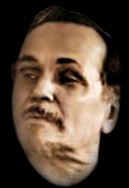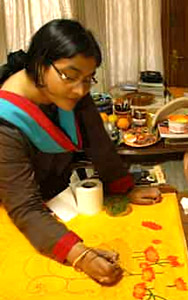
Jayasri
Burman
Jayasri
Burman is a noted contemporary Indian painter. She was born in 1960.
She received her training in fine arts from the Kala Bhavan in
Shantiniketan, and later from the Visual College of Art, Kolkata.
Eventually she received training under the illustrious Monsieur Ceizerzi
in print making in Paris. Jayasri Burman hails from a family of
prominent artists. She is married to the celebrated artist Paresh Maity.
Her uncle Sakti Burman, residing in France, is an illustrious Indian
artist. Expert artist Maya Burman is her cousin.
Jayasri Burman`s work can be regarded as masterpiece, which has `a
dream-like and lyrical quality with unique sensitivity`. Her works are
primarily inspired from the Indian folk element. Through each of her
creation the refreshing quality of forthrightness and honesty is
reflected. The originality of her paintings is very delighting. The
ornamental and contriving element of the folk style is very minutely
woven into the patterns of her canvas. But whatever the case may be,
originality and natural charm is always present in her creations.
Jayasri Burman`s paintings never face the lack of sophistication. These
qualities of her creation are considered exclusively her own.
Women are the main theme of Jayasri Burman`s paintings. They have always
been given a significant place in her creations. She is not a feminist,
but has always attempted to see the women content in various aspects of
life. Her women are `free and at one with Nature, sometimes they are a
coronated ceremonial bird, and at others, a mother Goddess or a creature
of the woods`. Her works also expresses her intimacy with nature.
Through her paintings, the lush green environs, the crossbred imagery of
a woman, the moribund pools that divulge the flamed colours of "Basant"
(spring) are reinterpreted. The image of woman in her painting is more
bird-like in her poise and form.
The body of work of Jayasri Burman brings out an unconscious debarred
energy that can be found in the surroundings of Shantiniketan, from
where she has obtained her finest skills in painting. `The dance of
colour` is her current vehicle of expression. The responsible factor
behind this grace is the development of her maturity and her own
satisfaction with life. What she had benefitted then has helped her to
respond to the wide-ranging facets of Indian culture- this new kind of
Nature has enthused the artist to direct her eye upon the paint.
Red, blue or radiant saffron are the colours frequently used by Jayasri
Burman. Her works can be seen as `commitment to an art that is derived
from the experience of the landscape - it is more than a matter of
seeing things afresh - it is the perception that is aware of the
transience and mutability of landscape`. Her works depict closeness in
every sphere, sometimes it admits the viewers and they started realising
themselves to be a part of it. One step into the world of Jayasri
Burman`s work, and one becomes stimulant in responding to the
nonconformist canons of beauty and partake of the choreography of
Nature. She has won several prizes for her art works. In 1987, she
received Certificate of Merit, All India Youth Art Exhibition; in 1985
she was awarded the National Award. In 1979 Burman was felicitated by
the College of Visual Arts in Tempera for Outstanding Merit in the
Annual Exhibition.
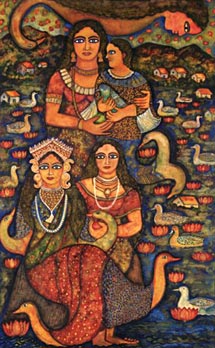
She
has exhibited her works in India, and overseas as well. In 2005, she
organised an exhibition, namely "The Family" where she had exhibited
paintings of her artist family members. Some notable exhibitions of
Jayasri Burman are-- 2006 `Sacred Feminine`, Art Musings, Mumbai; 2005
Fairytales & Laments- The Mythology of Jayasri Burman, Arts India,
Palo Alto; 2002 Gallery Sumukha, Bangalore; 1997-99-2000 Gallerie
Ganesha, New Delhi; 1992 Pundole Art Gallery, Mumbai; 1985-90-92-96
Chitrakoot Gallery, Kolkata; 2006 The Indiart Show 2006, Lasalle - Sia,
Singapore; 2005 `The Family` Art Musings, Mumbai; 2005, CIMA, Kolkata;
2004 `Shadanga` Gallerie Ganesha, New Delhi; 2004 Visual Art Gallery,
London; 2003 Workshop in Egypt with Indian Contemporary Artists by BAYAR
ABS; 2001-02 Modi Foundation, London; 2001-02 `Bollywood Show`,
Selfridges, London; 2001-02 Group Show of Bengal Art, Centre of
International Modern Art (CIMA), Kolkata; 2002 `The Family-3`, with
Sakti Burman, Maya Burman, Jayasri Burman, Apparao Gallery, Chennai;
2001 `Indian Contemporary`, Hong Kong; 2001 `Indian Contemporary Fine
Art`, Los Angeles, USA; 1999 `Emerging Trends`, Centre of International
Modern Art (CIMA), Kolkata; 1997 `Panchadashi`, Gallery La Mere,
Kolkata; 1997 `The Best of Bengal from Independence to the Present`,
Chitrakoot Art Gallery, Kolkata; 1996 `Urban Signals, Shifting
Images-II`, Birla Academy of Art and Culture, Mumbai; 1994 Exhibition of
paintings and Sculptures by Eminent Contemporary Artists, Chitrakoot
Art Gallery, Kolkata; 1993 `Life-Long`, Emerald Isle, Kolkata; 1992 `The
Baijis`, Chitrakoot Art Gallery, Kolkata; 1991 Annual Exhibition of
Graphics, Paintings and Sculptures, Gallery BF-14, Kolkata; 1991 `A
Tribute to Vincent Van Gogh`, Vadehra Art Gallery, New Delhi; 1990
`Kolkata through the Eyes of Painters`, Birla Academy of Art and
Culture, Kolkata; 1989 `Young Faces in Contemporary Indian Art`, Birla
Academy of Art and Culture, Kolkata; 1999 `Summer Show by Contemporary
Eminent Artists of Bengal`, Chitrakoot Art Gallery, Kolkata; 1984 Three
Person Exhibition, Paris; 1987 International Triennale, Intergraphic,
Germany; 1986 Bharat Bhavan Biennale, Bhopal; 1983-85 National
Exhibition, Lalit Kala Akademi, New Delhi; 1983-85 National Exhibition,
Lalit Kala Akademi, Kolkata; 1983-85 All India Fine Arts and Crafts
Society (AIFACS), New Delhi.
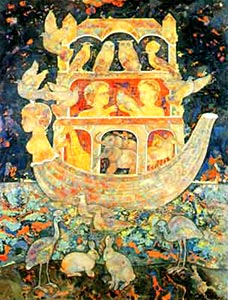 He
uses complementary colours, varied textures thereby holding out a dream
world of harmony - a world that is an abode of abiding peace. The
viewer feels assured of peace and happiness in the world of Burman`s
paintings. The trees, the birds and the animals; the flowers; the open
water bodies, the boats, the flutists and drummer boys are depicted in
his works. Reality meets and blends with his dream world. Realism is
very much a part of his paintings however he returns to his dream world
time and again.
He
uses complementary colours, varied textures thereby holding out a dream
world of harmony - a world that is an abode of abiding peace. The
viewer feels assured of peace and happiness in the world of Burman`s
paintings. The trees, the birds and the animals; the flowers; the open
water bodies, the boats, the flutists and drummer boys are depicted in
his works. Reality meets and blends with his dream world. Realism is
very much a part of his paintings however he returns to his dream world
time and again.
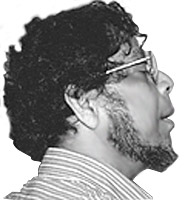

 She
has exhibited her works in India, and overseas as well. In 2005, she
organised an exhibition, namely "The Family" where she had exhibited
paintings of her artist family members. Some notable exhibitions of
Jayasri Burman are-- 2006 `Sacred Feminine`, Art Musings, Mumbai; 2005
Fairytales & Laments- The Mythology of Jayasri Burman, Arts India,
Palo Alto; 2002 Gallery Sumukha, Bangalore; 1997-99-2000 Gallerie
Ganesha, New Delhi; 1992 Pundole Art Gallery, Mumbai; 1985-90-92-96
Chitrakoot Gallery, Kolkata; 2006 The Indiart Show 2006, Lasalle - Sia,
Singapore; 2005 `The Family` Art Musings, Mumbai; 2005, CIMA, Kolkata;
2004 `Shadanga` Gallerie Ganesha, New Delhi; 2004 Visual Art Gallery,
London; 2003 Workshop in Egypt with Indian Contemporary Artists by BAYAR
ABS; 2001-02 Modi Foundation, London; 2001-02 `Bollywood Show`,
Selfridges, London; 2001-02 Group Show of Bengal Art, Centre of
International Modern Art (CIMA), Kolkata; 2002 `The Family-3`, with
Sakti Burman, Maya Burman, Jayasri Burman, Apparao Gallery, Chennai;
2001 `Indian Contemporary`, Hong Kong; 2001 `Indian Contemporary Fine
Art`, Los Angeles, USA; 1999 `Emerging Trends`, Centre of International
Modern Art (CIMA), Kolkata; 1997 `Panchadashi`, Gallery La Mere,
Kolkata; 1997 `The Best of Bengal from Independence to the Present`,
Chitrakoot Art Gallery, Kolkata; 1996 `Urban Signals, Shifting
Images-II`, Birla Academy of Art and Culture, Mumbai; 1994 Exhibition of
paintings and Sculptures by Eminent Contemporary Artists, Chitrakoot
Art Gallery, Kolkata; 1993 `Life-Long`, Emerald Isle, Kolkata; 1992 `The
Baijis`, Chitrakoot Art Gallery, Kolkata; 1991 Annual Exhibition of
Graphics, Paintings and Sculptures, Gallery BF-14, Kolkata; 1991 `A
Tribute to Vincent Van Gogh`, Vadehra Art Gallery, New Delhi; 1990
`Kolkata through the Eyes of Painters`, Birla Academy of Art and
Culture, Kolkata; 1989 `Young Faces in Contemporary Indian Art`, Birla
Academy of Art and Culture, Kolkata; 1999 `Summer Show by Contemporary
Eminent Artists of Bengal`, Chitrakoot Art Gallery, Kolkata; 1984 Three
Person Exhibition, Paris; 1987 International Triennale, Intergraphic,
Germany; 1986 Bharat Bhavan Biennale, Bhopal; 1983-85 National
Exhibition, Lalit Kala Akademi, New Delhi; 1983-85 National Exhibition,
Lalit Kala Akademi, Kolkata; 1983-85 All India Fine Arts and Crafts
Society (AIFACS), New Delhi.
She
has exhibited her works in India, and overseas as well. In 2005, she
organised an exhibition, namely "The Family" where she had exhibited
paintings of her artist family members. Some notable exhibitions of
Jayasri Burman are-- 2006 `Sacred Feminine`, Art Musings, Mumbai; 2005
Fairytales & Laments- The Mythology of Jayasri Burman, Arts India,
Palo Alto; 2002 Gallery Sumukha, Bangalore; 1997-99-2000 Gallerie
Ganesha, New Delhi; 1992 Pundole Art Gallery, Mumbai; 1985-90-92-96
Chitrakoot Gallery, Kolkata; 2006 The Indiart Show 2006, Lasalle - Sia,
Singapore; 2005 `The Family` Art Musings, Mumbai; 2005, CIMA, Kolkata;
2004 `Shadanga` Gallerie Ganesha, New Delhi; 2004 Visual Art Gallery,
London; 2003 Workshop in Egypt with Indian Contemporary Artists by BAYAR
ABS; 2001-02 Modi Foundation, London; 2001-02 `Bollywood Show`,
Selfridges, London; 2001-02 Group Show of Bengal Art, Centre of
International Modern Art (CIMA), Kolkata; 2002 `The Family-3`, with
Sakti Burman, Maya Burman, Jayasri Burman, Apparao Gallery, Chennai;
2001 `Indian Contemporary`, Hong Kong; 2001 `Indian Contemporary Fine
Art`, Los Angeles, USA; 1999 `Emerging Trends`, Centre of International
Modern Art (CIMA), Kolkata; 1997 `Panchadashi`, Gallery La Mere,
Kolkata; 1997 `The Best of Bengal from Independence to the Present`,
Chitrakoot Art Gallery, Kolkata; 1996 `Urban Signals, Shifting
Images-II`, Birla Academy of Art and Culture, Mumbai; 1994 Exhibition of
paintings and Sculptures by Eminent Contemporary Artists, Chitrakoot
Art Gallery, Kolkata; 1993 `Life-Long`, Emerald Isle, Kolkata; 1992 `The
Baijis`, Chitrakoot Art Gallery, Kolkata; 1991 Annual Exhibition of
Graphics, Paintings and Sculptures, Gallery BF-14, Kolkata; 1991 `A
Tribute to Vincent Van Gogh`, Vadehra Art Gallery, New Delhi; 1990
`Kolkata through the Eyes of Painters`, Birla Academy of Art and
Culture, Kolkata; 1989 `Young Faces in Contemporary Indian Art`, Birla
Academy of Art and Culture, Kolkata; 1999 `Summer Show by Contemporary
Eminent Artists of Bengal`, Chitrakoot Art Gallery, Kolkata; 1984 Three
Person Exhibition, Paris; 1987 International Triennale, Intergraphic,
Germany; 1986 Bharat Bhavan Biennale, Bhopal; 1983-85 National
Exhibition, Lalit Kala Akademi, New Delhi; 1983-85 National Exhibition,
Lalit Kala Akademi, Kolkata; 1983-85 All India Fine Arts and Crafts
Society (AIFACS), New Delhi.
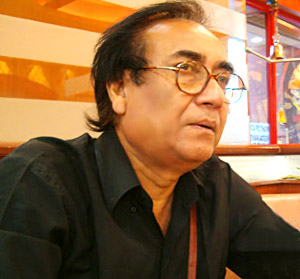
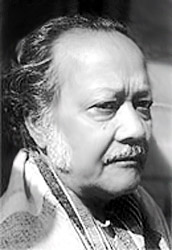
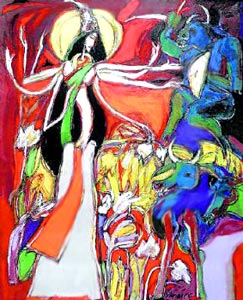 Dhiraj
Choudhury has curated and organized workshops and exhibitions on social
theme `Their Story` at Manipur, Madhya Pradesh, Rajasthan and Delhi. On
1982 he became the advisor of `Philosophy of Education for Contemporary
Youth` sponsored by ICCR and Department of Culture, Govt. of India. He
visited Bangladesh and gave lectures in Dhaka Art College, where there
was interaction between Bagladeshi and Indian artists. Beside these
Dhiraj Choudhury is involved in many other social works. He is the Art
Advisor at the Department of Culture, National Gallery of Modern Art,
New Delhi. He was also the Art Advisor of HUDCO, New Delhi and was
associated with the Voluntary Health Organization,India. Dhiraj
Choudhury initiated `Sketch Club` among his students, organized `Womens`
Painters Group`, `Line`, `Quartet Artist` and `Artist Forum`. He is
also associated with Gallery 26.
Dhiraj
Choudhury has curated and organized workshops and exhibitions on social
theme `Their Story` at Manipur, Madhya Pradesh, Rajasthan and Delhi. On
1982 he became the advisor of `Philosophy of Education for Contemporary
Youth` sponsored by ICCR and Department of Culture, Govt. of India. He
visited Bangladesh and gave lectures in Dhaka Art College, where there
was interaction between Bagladeshi and Indian artists. Beside these
Dhiraj Choudhury is involved in many other social works. He is the Art
Advisor at the Department of Culture, National Gallery of Modern Art,
New Delhi. He was also the Art Advisor of HUDCO, New Delhi and was
associated with the Voluntary Health Organization,India. Dhiraj
Choudhury initiated `Sketch Club` among his students, organized `Womens`
Painters Group`, `Line`, `Quartet Artist` and `Artist Forum`. He is
also associated with Gallery 26.




